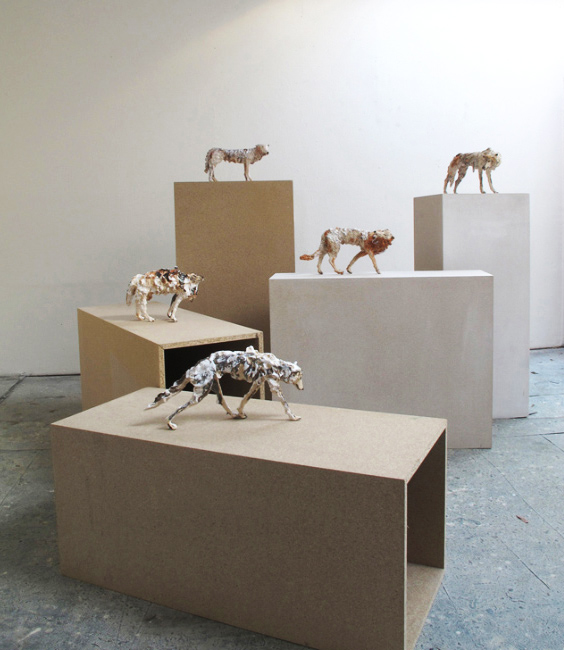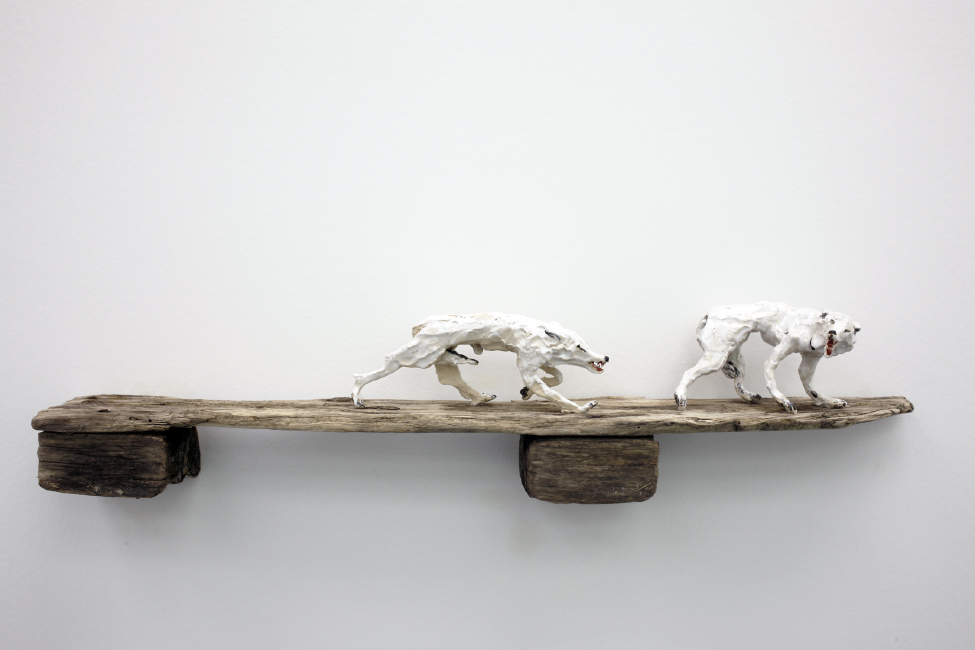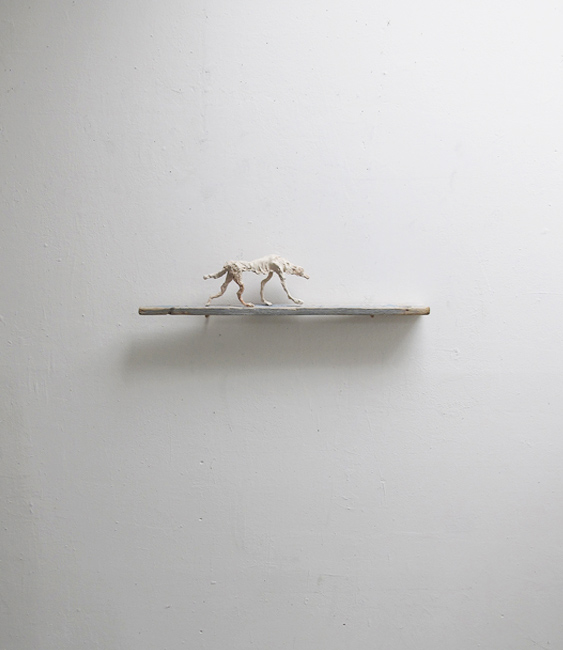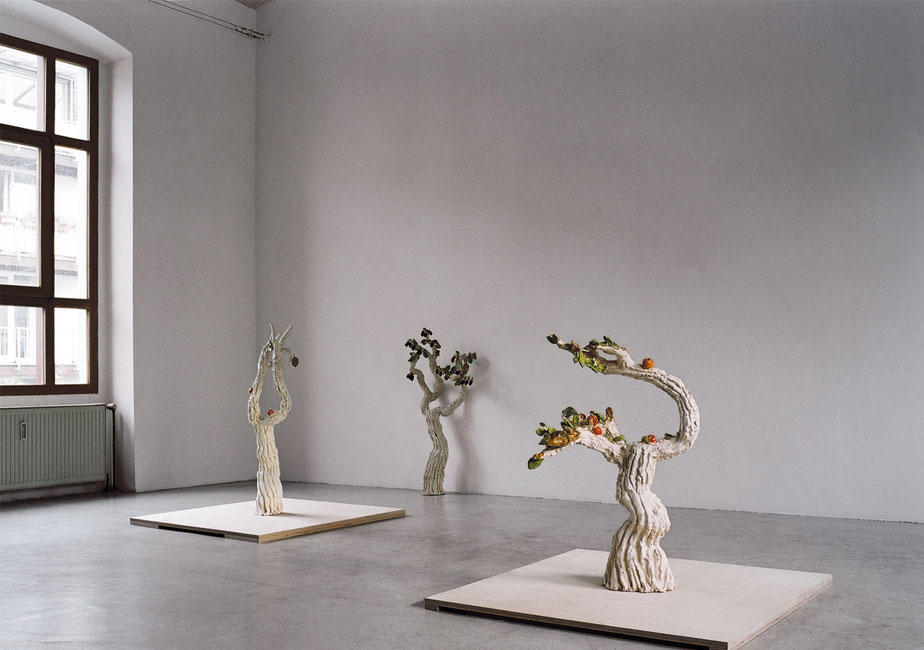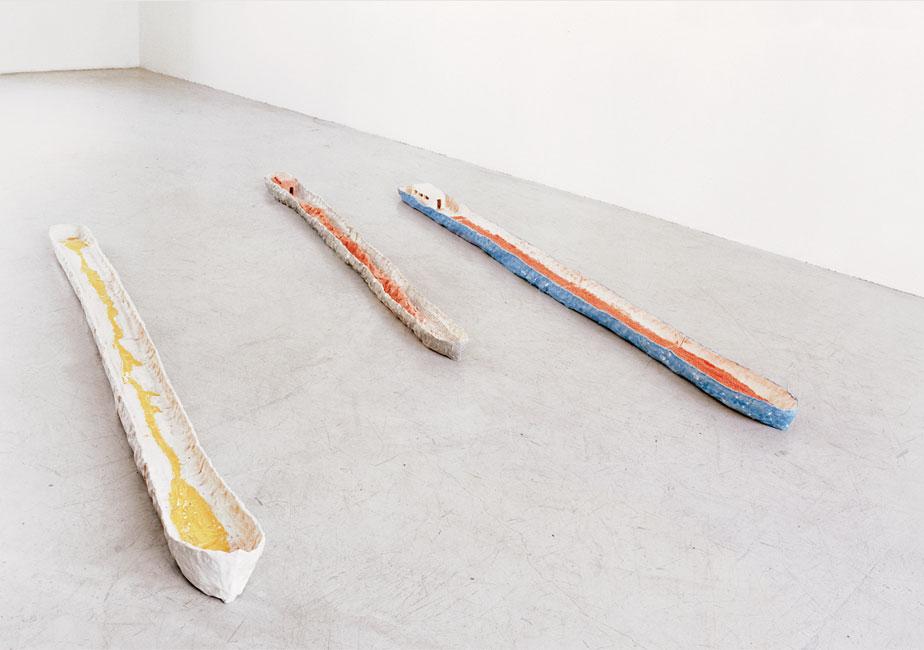Read about: Sculpture
A text for the exhibition "Along the Voices", by Anne Mager, 2023
Not only what we say, but also how - and in which language - we formulate, emphasize, pronounce or even sing what we have told, thought or dreamed has an immeasurable effect on the content and interpersonal interaction. Language in all its diversity organizes our thoughts and actions and serves to form our identities. According to Fontane, language is the most human thing we have.
Carol Pilars de Pilar collected over a period of two years and compiled a total of 67 different audio recordings of people of different ages and backgrounds, in their environment, their city and while traveling. The artist gave the participants time to think about what they wanted to talk about in the recording, what moves them and which memories, experiences, emotions and traditions are of particular importance to them. The stories in 32 languages were deliberately not translated. Instead, the anecdotes, poems and songs resound in different rhythms, sound patterns and narrative structures in Italian, Finnish, Yiddish, Twi, Fula or Ukrainian.
"Along the Voices", visitors move through the installation of the same name, through corridors and separees formed by colorful, built textile - an spatial structure in which simple furniture constructions made of bulky waste and plywood invite visitors to sit or lie down and, above all, to listen. Outside these protective yet permeable areas, the artist presents ceramic figures, not individually on pedestals, but in direct relation to each other, facing each other, standing next to each other or even isolated. The black wooden planks on which they stand are reminiscent of a stage - and yet the installation remains un-theatrical. Sometimes readable as male, sometimes as female or both, in different colors, upright and yet fragile in their materiality, the figures reflect the diversity of human bodies and identities and at the same time show the commonality, the sameness across gender norms and skin colors.
Humans and humanity, life in all its diversity, play a central role in the work of the Düsseldorf artist. Her interest in the complexity that defines us is reflected in the diversity of her work: in her sculptures, installations, audio works, texts, drawings, watercolors and collages, she explores the everyday, the individual and the imperfect, similarities and differences. Her vessel-like and stool-like objects, which evoke associations with moments of togetherness and friendship and which she displays in the back of the exhibition on the floor and on delicate plinths, "remind us of being human", says Carol Pilars de Pilar, and are like mementos for her. The watercolors, photos and collages from the "Passage" installation are also about remembering and sharing, about personal moments and the human body. The anecdotes from her childhood, puberty and youth, which people from different countries shared with her (to be read in the artist's book "Alltag / Everyday Life / Passage"), build a portrait snapshot with the drawn and painted body fragments and tell of the discovery of one's own body, in and changing relationships. In another series of drawings, the artist explores perceptions that go beyond the purely cognitive perception beyond by drawing completely freely and intuitively on the sheet with her eyes closed to classical, pop music, jazz or chanson, for example.
In her unflagging interest in the Conditio Humana, the nature of man and the basic parameters of our existence, Carol Pilars de Pilars explores the enormous range of human biographies and individual perception in her works and series. Feelings and interactions, sexuality, migration and memory are just some of the thematic worlds that she explores in a curious, empathetic, sometimes playful and humorous way. "Along the Voices" invites you to enter the labyrinth of the familiar and the seemingly foreign, to listen and empathize.
Text für die Ausstellung "Along the Voices" von Anne Mager, 2023
Nicht nur was wir sagen, sondern auch wie – und in welcher Sprache – wir das Erzählte, Gedachte oder Geträumte formulieren, betonen, aussprechen oder gar singen, hat eine unmittelbare Wirkung auf den Inhalt und die zwischenmenschliche Interaktion. Sprache in all ihrer Vielseitgkeit organisiert unser Denken und Handeln und dient der Identitätsbildung. Das Menschlichste, was wir haben, sei doch die Sprache, so Fontane.
Carol Pilars de Pilar hat über zwei Jahre hinweg Stimmen gesammelt und insgesamt 67 verschiedene Audioaufnahmen von Menschen unterschiedlichsten Alters und Herkunft, in ihrem Umfeld, ihrer Stadt und auf Reisen zusammengetragen. Die Künstlerin gab den Beteiligten Zeit, sich zu überlegen, worüber sie bei der Aufnahme sprechen wollten, was sie bewegt und welche Erinnerungen, Erlebnisse, Emotionen und Überlieferungen für sie von besonderer Bedeutung sind. Die Erzählungen in 32 Sprachen wurden bewusst nicht übersetzt. Stattdessen erklingen die Anekdoten, Gedichte und Lieder in unterschiedlichen Rhythmen, Lautmustern und Erzählstrukturen auf Italienisch, Finnisch, Jiddisch, Twi, Fula oder Ukrainisch.
„Along the Voices“ (Entlang der Stimmen) bewegen sich dann auch die Besucher*innen durch die gleichnamige Installation, durch Gänge und Separees, die von farbigen, gebatikten Stoffbahnen gebildet werden – ein intimes Raumgefüge, in denen einfache Möbelkonstruktionen aus Rest- und Sperrholz zum Verweilen im Sitzen oder Liegen und vor allem zum Zuhören einladen. Außerhalb dieser schützenden und doch durchlässigen Bereiche präsentiert die Künstlerin Keramikfiguren, nicht einzeln auf Sockeln, sondern in direktem Bezug zueinander, einander zugewendet, neben einander stehend oder auch vereinzelt. Die schwarzen Holzplatten, auf denen sie stehen, erinnern an eine Bühne – und doch bleibt die Installation untheatralisch. Mal männlich, mal weiblich lesbar oder auch beides, verschiedenfarbig, aufrechtstehend und doch fragil in ihrer Materialität, geben die Figuren die Vielfalt der menschlichen Körper und Identitäten wieder und zeigen gleichzeitig das Gemeinsame, Gleiche über Geschlechternormen und Hautfarben hinweg auf.
Mensch und Menschlichkeit, das Leben in seiner ganzen Diversität, spielt im Werk der Düsseldorfer Künstlerin eine zentrale Rolle. Ihr Interesse an der Vielschichtigkeit, die uns ausmacht, spiegelt sich in der Vielseitigkeit ihrer Arbeit wider: In ihren Skulpturen, Installationen, Audioarbeiten, Texten, Zeichnungen, Aquarellen und Collagen erforscht sie das Alltägliche, das Individuelle und Unperfekte, Ähnlichkeiten und Unterschiede. Auch ihre gefäßnahen und hockerartigen Objekte, die Assoziationen zu Momenten des Zusammenseins und der Gastfreundschaft wecken und welche sie im hinteren Teil der Ausstellung auf dem Boden sowie auf feingliedrigen Sockeln zeigt, „erinnern an das Menschsein“, so Carol Pilars de Pilar und sind für sie wie Erinnerungsstücke. Um das Erinnern und Teilen, um persönliche Momente und den menschlichen Körper geht es auch in den Aquarellen, Fotos und Collagen aus der Installation „Passage“. Die Anekdoten aus ihrer Kindheit, Pubertät und Jugend, die Menschen aus verschiedensten Ländern mit ihr teilten (nachzulesen im Künstlerinnenbuch „Alltag / Everyday Life / Passage“), bilden mit den gezeichneten und gemalten Körperfragmenten portraithafte Momentaufnahmen und erzählen vom Entdecken des eigenen Körpers, Intimität und wechselhaften Beziehungen. In einer weiteren Zeichnungsreihe erkundet die Künstlerin die über das rein Kognitive hinausgehende Wahrnehmung, indem sie völlig frei und intuitiv bei geschlossenen Augen zu etwa Klassik, Popmusik, Jazz oder Chanson auf das Blatt zeichnete und sprühte.
In ihrem nicht nachlassenden Interesse an der Conditio Humana, der Natur des Menschen und den Grundparametern unserer Existenz, erkundet Carol Pilars de Pilars in ihren Arbeiten und Serien die enorme Bandbreite menschlicher Biografien und individueller Wahrnehmung. Empfindungen und Interaktionen, Sexualität, Migration und Erinnerung sind nur einige der Themenwelten, die sie neugierig, empathisch, oftmals spielerisch und humorvoll erforscht. „Along the Voices“ lädt ein, sich in das Labyrinth des Vertrauten und des scheinbar Fremden zu begeben, zuzuhören und mitzufühlen.
Text:Christoph Poeggeler 2013
Pilars finds her themes in a profound perception of people and nature. Her view is guided by sympathy and respect but also by curiosity and wonder, which her art reflects inimitably.In her depiction of animals and plants the artist understands to empathize with the creatural, the prototypical of their nature. She succeeds in expressing the vulnerability as well as the wildness—the otherness—of these beings. Her animal sculptures are the result of her ability to observe nature in a highly sensitive manner and grow through the power of the natural materials the artist collects—like driftwood pieces she uses as a base in her assembles of figures. The depicted wolves and dogs therefore appear to be at home in their natural context. The interplay of human-made and found natural materials, of molded burnt clay and driftwood sanded down by natural processes works harmoniously and in the end even determines each other. Analog to how Pilars uses found driftwood covered in patina, she treats selected sound tracks and fragments of language audible next to large-sized but delicate watercolor portraits—merging into an installation. Here are carefully collected and selected pieces of interviews that were recorded during the portrait sessions with her subjects. They tell a fragmented story of the life of their narrator and they too are covered in patina and fragility, tenderness or the briskness of the voice of the individual.Pilars doesn't just want to describe the physical facts of a distinctive human face but she is fascinated by the mental dimension that forms through mutually opening up in the conversations during the portrait sessions and is curious how this influences her work. This process requires a true openness and empathy, qualities that are authentic in Carol Pilars de Pilar and are congenially expressed in her art. In her most recent work, small creatures are balancing carelessly over profound abysses. Here, delicate metal structures are in contrast to the spontaneously molded clay "sketches" of the miniature flâneurs. The art of Pilars de Pilar emanates a great humanistic sympathy for her subjects and their relationship to the world.
Deutscher Text:
Christoph Poeggeler 2013
Pilars findet ihre Themen in einer profunden Wahrnehmung von Mensch und Natur. Dass ihr Blick von Sympathie und Respekt, aber auch von Neugier und Wundern geleitet ist, spiegelt ihre Kunst in einzigartiger Weise wieder. Bei ihren Tier- und Pflanzendarstellungen versteht es die Künstlerin, sich tief in das Typische, das Kreatürliche der Natur einzufühlen. Es gelingt ihr, die Verletzlichkeit und zugleich die Wildheit - das Andere - dieser Wesen auszudrücken. Ihre Tierplastiken sind Ergebnis einer hochsensiblen Naturbeobachtung, profitieren aber auch von der Kraft des Naturmaterials der von ihr gesammelten Treibholzfundstücke, die sie als Sockel ihren Figurenensembles beifügt. Ähnlich wie mit den Patina-behafteten Fundstücken des Treibguts geht Carol Pilars mit ausgewählten Tonspuren und Sprachfetzen um, welche sie installativ großformatigen, doch gleichzeitig zarten Aquarell-Porträts gegenüberstellt. Hier sind Fundstücke aus Gesprächen während der Porträtsitzungen gezielt gesammelt und ausgesucht worden. Auch sie erzählen fragmentarisch von der Lebensgeschichte ihrer Erzähler. Auch sie besitzen die Patina und Brüchigkeit, Zartheit oder Frische der Stimmen der porträtierten Individuen. Pilars möchte nicht nur die physischen Fakten eines unverwechselbaren Menschenantlitzes wiedergeben, sondern sie ist auch von der psychischen Dimension einer gegenseitigen Öffnung im Gespräch während einer Modellsitzung fasziniert. Und neugierig auf deren Auswirkung auf ihre Kunst. Dies setzt Weltoffenheit und Mitfühlen voraus, Eigenschaften, die bei Carol Pilars authentisch sind und die sich in ihrer Kunst kongenial ausdrücken. In ihren jüngsten Arbeiten balancieren Wesen sorglos über hohen Abgründen. Filigrane Stahlgerüste kontrastieren hier mit spontan- modellierten Tonskizzen kleiner Figuren.
// close
A text for the exhibition "Along the Voices", by Anne Mager, 2023
Not only what we say, but also how - and in which language - we formulate, emphasize, pronounce or even sing what we have told, thought or dreamed has an immeasurable effect on the content and interpersonal interaction. Language in all its diversity organizes our thoughts and actions and serves to form our identities. According to Fontane, language is the most human thing we have.
Carol Pilars de Pilar collected over a period of two years and compiled a total of 67 different audio recordings of people of different ages and backgrounds, in their environment, their city and while traveling. The artist gave the participants time to think about what they wanted to talk about in the recording, what moves them and which memories, experiences, emotions and traditions are of particular importance to them. The stories in 32 languages were deliberately not translated. Instead, the anecdotes, poems and songs resound in different rhythms, sound patterns and narrative structures in Italian, Finnish, Yiddish, Twi, Fula or Ukrainian.
"Along the Voices", visitors move through the installation of the same name, through corridors and separees formed by colorful, built textile - an spatial structure in which simple furniture constructions made of bulky waste and plywood invite visitors to sit or lie down and, above all, to listen. Outside these protective yet permeable areas, the artist presents ceramic figures, not individually on pedestals, but in direct relation to each other, facing each other, standing next to each other or even isolated. The black wooden planks on which they stand are reminiscent of a stage - and yet the installation remains un-theatrical. Sometimes readable as male, sometimes as female or both, in different colors, upright and yet fragile in their materiality, the figures reflect the diversity of human bodies and identities and at the same time show the commonality, the sameness across gender norms and skin colors.
Humans and humanity, life in all its diversity, play a central role in the work of the Düsseldorf artist. Her interest in the complexity that defines us is reflected in the diversity of her work: in her sculptures, installations, audio works, texts, drawings, watercolors and collages, she explores the everyday, the individual and the imperfect, similarities and differences. Her vessel-like and stool-like objects, which evoke associations with moments of togetherness and friendship and which she displays in the back of the exhibition on the floor and on delicate plinths, "remind us of being human", says Carol Pilars de Pilar, and are like mementos for her. The watercolors, photos and collages from the "Passage" installation are also about remembering and sharing, about personal moments and the human body. The anecdotes from her childhood, puberty and youth, which people from different countries shared with her (to be read in the artist's book "Alltag / Everyday Life / Passage"), build a portrait snapshot with the drawn and painted body fragments and tell of the discovery of one's own body, in and changing relationships. In another series of drawings, the artist explores perceptions that go beyond the purely cognitive perception beyond by drawing completely freely and intuitively on the sheet with her eyes closed to classical, pop music, jazz or chanson, for example.
In her unflagging interest in the Conditio Humana, the nature of man and the basic parameters of our existence, Carol Pilars de Pilars explores the enormous range of human biographies and individual perception in her works and series. Feelings and interactions, sexuality, migration and memory are just some of the thematic worlds that she explores in a curious, empathetic, sometimes playful and humorous way. "Along the Voices" invites you to enter the labyrinth of the familiar and the seemingly foreign, to listen and empathize.
Text für die Ausstellung "Along the Voices" von Anne Mager, 2023
Nicht nur was wir sagen, sondern auch wie – und in welcher Sprache – wir das Erzählte, Gedachte oder Geträumte formulieren, betonen, aussprechen oder gar singen, hat eine unmittelbare Wirkung auf den Inhalt und die zwischenmenschliche Interaktion. Sprache in all ihrer Vielseitgkeit organisiert unser Denken und Handeln und dient der Identitätsbildung. Das Menschlichste, was wir haben, sei doch die Sprache, so Fontane.
Carol Pilars de Pilar hat über zwei Jahre hinweg Stimmen gesammelt und insgesamt 67 verschiedene Audioaufnahmen von Menschen unterschiedlichsten Alters und Herkunft, in ihrem Umfeld, ihrer Stadt und auf Reisen zusammengetragen. Die Künstlerin gab den Beteiligten Zeit, sich zu überlegen, worüber sie bei der Aufnahme sprechen wollten, was sie bewegt und welche Erinnerungen, Erlebnisse, Emotionen und Überlieferungen für sie von besonderer Bedeutung sind. Die Erzählungen in 32 Sprachen wurden bewusst nicht übersetzt. Stattdessen erklingen die Anekdoten, Gedichte und Lieder in unterschiedlichen Rhythmen, Lautmustern und Erzählstrukturen auf Italienisch, Finnisch, Jiddisch, Twi, Fula oder Ukrainisch.
„Along the Voices“ (Entlang der Stimmen) bewegen sich dann auch die Besucher*innen durch die gleichnamige Installation, durch Gänge und Separees, die von farbigen, gebatikten Stoffbahnen gebildet werden – ein intimes Raumgefüge, in denen einfache Möbelkonstruktionen aus Rest- und Sperrholz zum Verweilen im Sitzen oder Liegen und vor allem zum Zuhören einladen. Außerhalb dieser schützenden und doch durchlässigen Bereiche präsentiert die Künstlerin Keramikfiguren, nicht einzeln auf Sockeln, sondern in direktem Bezug zueinander, einander zugewendet, neben einander stehend oder auch vereinzelt. Die schwarzen Holzplatten, auf denen sie stehen, erinnern an eine Bühne – und doch bleibt die Installation untheatralisch. Mal männlich, mal weiblich lesbar oder auch beides, verschiedenfarbig, aufrechtstehend und doch fragil in ihrer Materialität, geben die Figuren die Vielfalt der menschlichen Körper und Identitäten wieder und zeigen gleichzeitig das Gemeinsame, Gleiche über Geschlechternormen und Hautfarben hinweg auf.
Mensch und Menschlichkeit, das Leben in seiner ganzen Diversität, spielt im Werk der Düsseldorfer Künstlerin eine zentrale Rolle. Ihr Interesse an der Vielschichtigkeit, die uns ausmacht, spiegelt sich in der Vielseitigkeit ihrer Arbeit wider: In ihren Skulpturen, Installationen, Audioarbeiten, Texten, Zeichnungen, Aquarellen und Collagen erforscht sie das Alltägliche, das Individuelle und Unperfekte, Ähnlichkeiten und Unterschiede. Auch ihre gefäßnahen und hockerartigen Objekte, die Assoziationen zu Momenten des Zusammenseins und der Gastfreundschaft wecken und welche sie im hinteren Teil der Ausstellung auf dem Boden sowie auf feingliedrigen Sockeln zeigt, „erinnern an das Menschsein“, so Carol Pilars de Pilar und sind für sie wie Erinnerungsstücke. Um das Erinnern und Teilen, um persönliche Momente und den menschlichen Körper geht es auch in den Aquarellen, Fotos und Collagen aus der Installation „Passage“. Die Anekdoten aus ihrer Kindheit, Pubertät und Jugend, die Menschen aus verschiedensten Ländern mit ihr teilten (nachzulesen im Künstlerinnenbuch „Alltag / Everyday Life / Passage“), bilden mit den gezeichneten und gemalten Körperfragmenten portraithafte Momentaufnahmen und erzählen vom Entdecken des eigenen Körpers, Intimität und wechselhaften Beziehungen. In einer weiteren Zeichnungsreihe erkundet die Künstlerin die über das rein Kognitive hinausgehende Wahrnehmung, indem sie völlig frei und intuitiv bei geschlossenen Augen zu etwa Klassik, Popmusik, Jazz oder Chanson auf das Blatt zeichnete und sprühte.
In ihrem nicht nachlassenden Interesse an der Conditio Humana, der Natur des Menschen und den Grundparametern unserer Existenz, erkundet Carol Pilars de Pilars in ihren Arbeiten und Serien die enorme Bandbreite menschlicher Biografien und individueller Wahrnehmung. Empfindungen und Interaktionen, Sexualität, Migration und Erinnerung sind nur einige der Themenwelten, die sie neugierig, empathisch, oftmals spielerisch und humorvoll erforscht. „Along the Voices“ lädt ein, sich in das Labyrinth des Vertrauten und des scheinbar Fremden zu begeben, zuzuhören und mitzufühlen.
Text:Christoph Poeggeler 2013
Pilars finds her themes in a profound perception of people and nature. Her view is guided by sympathy and respect but also by curiosity and wonder, which her art reflects inimitably.In her depiction of animals and plants the artist understands to empathize with the creatural, the prototypical of their nature. She succeeds in expressing the vulnerability as well as the wildness—the otherness—of these beings. Her animal sculptures are the result of her ability to observe nature in a highly sensitive manner and grow through the power of the natural materials the artist collects—like driftwood pieces she uses as a base in her assembles of figures. The depicted wolves and dogs therefore appear to be at home in their natural context. The interplay of human-made and found natural materials, of molded burnt clay and driftwood sanded down by natural processes works harmoniously and in the end even determines each other. Analog to how Pilars uses found driftwood covered in patina, she treats selected sound tracks and fragments of language audible next to large-sized but delicate watercolor portraits—merging into an installation. Here are carefully collected and selected pieces of interviews that were recorded during the portrait sessions with her subjects. They tell a fragmented story of the life of their narrator and they too are covered in patina and fragility, tenderness or the briskness of the voice of the individual.Pilars doesn't just want to describe the physical facts of a distinctive human face but she is fascinated by the mental dimension that forms through mutually opening up in the conversations during the portrait sessions and is curious how this influences her work. This process requires a true openness and empathy, qualities that are authentic in Carol Pilars de Pilar and are congenially expressed in her art. In her most recent work, small creatures are balancing carelessly over profound abysses. Here, delicate metal structures are in contrast to the spontaneously molded clay "sketches" of the miniature flâneurs. The art of Pilars de Pilar emanates a great humanistic sympathy for her subjects and their relationship to the world.
Deutscher Text:
Christoph Poeggeler 2013
Pilars findet ihre Themen in einer profunden Wahrnehmung von Mensch und Natur. Dass ihr Blick von Sympathie und Respekt, aber auch von Neugier und Wundern geleitet ist, spiegelt ihre Kunst in einzigartiger Weise wieder. Bei ihren Tier- und Pflanzendarstellungen versteht es die Künstlerin, sich tief in das Typische, das Kreatürliche der Natur einzufühlen. Es gelingt ihr, die Verletzlichkeit und zugleich die Wildheit - das Andere - dieser Wesen auszudrücken. Ihre Tierplastiken sind Ergebnis einer hochsensiblen Naturbeobachtung, profitieren aber auch von der Kraft des Naturmaterials der von ihr gesammelten Treibholzfundstücke, die sie als Sockel ihren Figurenensembles beifügt. Ähnlich wie mit den Patina-behafteten Fundstücken des Treibguts geht Carol Pilars mit ausgewählten Tonspuren und Sprachfetzen um, welche sie installativ großformatigen, doch gleichzeitig zarten Aquarell-Porträts gegenüberstellt. Hier sind Fundstücke aus Gesprächen während der Porträtsitzungen gezielt gesammelt und ausgesucht worden. Auch sie erzählen fragmentarisch von der Lebensgeschichte ihrer Erzähler. Auch sie besitzen die Patina und Brüchigkeit, Zartheit oder Frische der Stimmen der porträtierten Individuen. Pilars möchte nicht nur die physischen Fakten eines unverwechselbaren Menschenantlitzes wiedergeben, sondern sie ist auch von der psychischen Dimension einer gegenseitigen Öffnung im Gespräch während einer Modellsitzung fasziniert. Und neugierig auf deren Auswirkung auf ihre Kunst. Dies setzt Weltoffenheit und Mitfühlen voraus, Eigenschaften, die bei Carol Pilars authentisch sind und die sich in ihrer Kunst kongenial ausdrücken. In ihren jüngsten Arbeiten balancieren Wesen sorglos über hohen Abgründen. Filigrane Stahlgerüste kontrastieren hier mit spontan- modellierten Tonskizzen kleiner Figuren.
// close




































